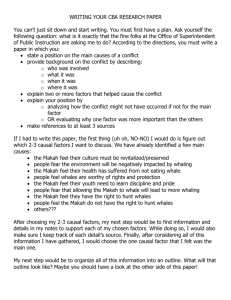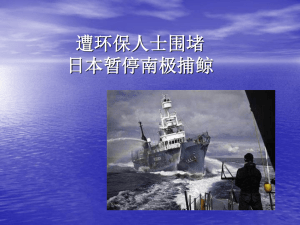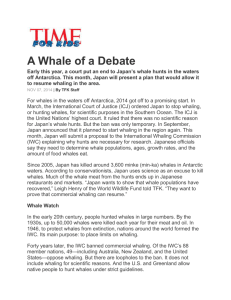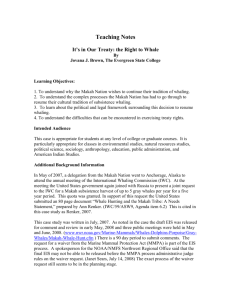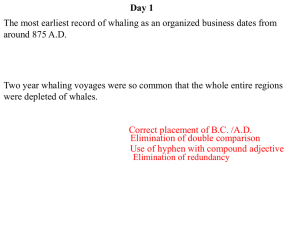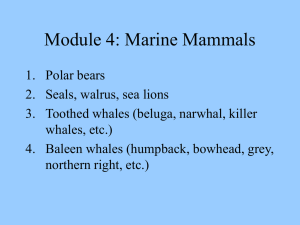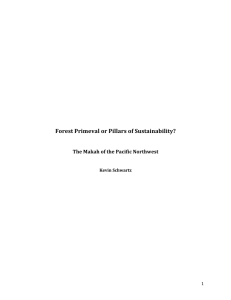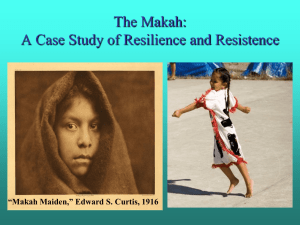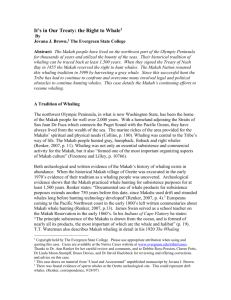File - Rhianna Hohbein
advertisement
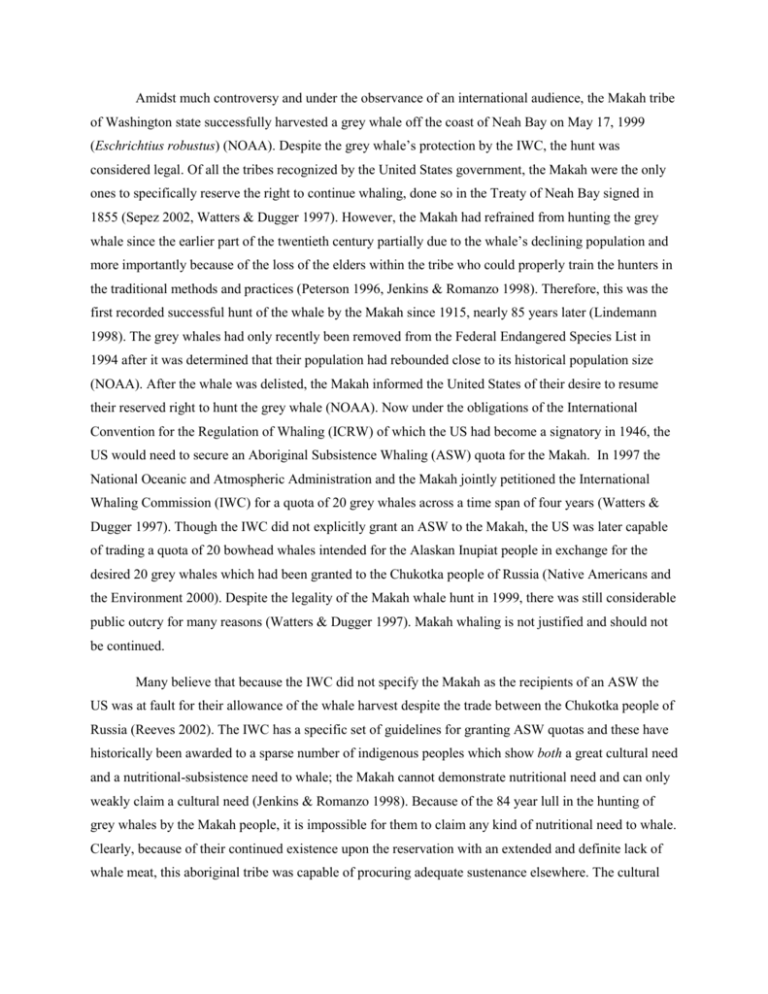
Amidst much controversy and under the observance of an international audience, the Makah tribe of Washington state successfully harvested a grey whale off the coast of Neah Bay on May 17, 1999 (Eschrichtius robustus) (NOAA). Despite the grey whale’s protection by the IWC, the hunt was considered legal. Of all the tribes recognized by the United States government, the Makah were the only ones to specifically reserve the right to continue whaling, done so in the Treaty of Neah Bay signed in 1855 (Sepez 2002, Watters & Dugger 1997). However, the Makah had refrained from hunting the grey whale since the earlier part of the twentieth century partially due to the whale’s declining population and more importantly because of the loss of the elders within the tribe who could properly train the hunters in the traditional methods and practices (Peterson 1996, Jenkins & Romanzo 1998). Therefore, this was the first recorded successful hunt of the whale by the Makah since 1915, nearly 85 years later (Lindemann 1998). The grey whales had only recently been removed from the Federal Endangered Species List in 1994 after it was determined that their population had rebounded close to its historical population size (NOAA). After the whale was delisted, the Makah informed the United States of their desire to resume their reserved right to hunt the grey whale (NOAA). Now under the obligations of the International Convention for the Regulation of Whaling (ICRW) of which the US had become a signatory in 1946, the US would need to secure an Aboriginal Subsistence Whaling (ASW) quota for the Makah. In 1997 the National Oceanic and Atmospheric Administration and the Makah jointly petitioned the International Whaling Commission (IWC) for a quota of 20 grey whales across a time span of four years (Watters & Dugger 1997). Though the IWC did not explicitly grant an ASW to the Makah, the US was later capable of trading a quota of 20 bowhead whales intended for the Alaskan Inupiat people in exchange for the desired 20 grey whales which had been granted to the Chukotka people of Russia (Native Americans and the Environment 2000). Despite the legality of the Makah whale hunt in 1999, there was still considerable public outcry for many reasons (Watters & Dugger 1997). Makah whaling is not justified and should not be continued. Many believe that because the IWC did not specify the Makah as the recipients of an ASW the US was at fault for their allowance of the whale harvest despite the trade between the Chukotka people of Russia (Reeves 2002). The IWC has a specific set of guidelines for granting ASW quotas and these have historically been awarded to a sparse number of indigenous peoples which show both a great cultural need and a nutritional-subsistence need to whale; the Makah cannot demonstrate nutritional need and can only weakly claim a cultural need (Jenkins & Romanzo 1998). Because of the 84 year lull in the hunting of grey whales by the Makah people, it is impossible for them to claim any kind of nutritional need to whale. Clearly, because of their continued existence upon the reservation with an extended and definite lack of whale meat, this aboriginal tribe was capable of procuring adequate sustenance elsewhere. The cultural need component of the granting of an ASW is based upon a “continuing traditional dependence on whaling and on the use of whales” (Gambell 1993). This, too, is clearly violated by the Makah’s 84 year lull in whaling. Though the tribe has a deep-rooted cultural heritage surrounding the hunt of whales, they simply cannot demonstrate any significant cultural need to whale; their culture remains intact despite the absence of whaling, and their claim for their cultural need to whale is based upon the desire for a “cultural revitalization” rather than a requirement of whaling to remain intact as a people—one of the qualifications of the Alaskan natives that allowed them access to an ASW to hunt bowhead whales (Reeves 2002; Jenkins & Romanzo 1998). In 1997 the IWC published a statement regarding a new quota for grey whales that would extend between 1998 and 2002; they reported that 640 grey whales could be taken during that time by “aborigine whose traditional and aboriginal and subsistence needs have been recognized” (Jenkins & Romanzo 1998). The IWC did not condemn the US for the Makah take of the whale in 1999, but some countries believe that the US had misconstrued the meaning of this document by claiming that it had led to the allowance of whaling for the Makah people whose traditional, aboriginal, and subsistence needs were NOT explicitly recognized by the IWC. While the harvest of twenty grey whales across the span of four years will not have any significant effect upon the population of the whale, the granting of an AWS to the Makah people alters the interpretation of the ICRW’s policy for aboriginal subsistence whaling and opens a door through which many other countries which could not previously acquire ASWs can follow (Jenkins &Romanzo 1998). The IWC has set a precedent for a hard and fast interpretation of ASWs, and the softening of this interpretation for sympathetic causes will only serve to weaken its resolve. The additional granting of AWSs to other countries whose aborigines arguably have stronger claims to cultural needs could eventually lead to a complete undermining of the moratorium on whaling. There is disagreement not only from outside parties and organizations, but also from within the tribe itself. Seven of the tribe’s elders spoke out against the Council’s movement to reinstate whaling in a half-page ad in the Peninsula Daily News (Watters & Dugger 1997). According to two elders, Alberta Thompson and Dotti Chamblin, who spoke directly with Brenda Peterson of the Seattle Times, there is no consensus among the tribe concerning the issue of resumed whaling. They claim that “‘the council went ahead without consent of the tribe’ ” and that when an unscheduled vote was called, only 104 of the 600 Makah were present, and only 70 of these 104 voted for the return of whaling (Peterson 1996). The two elders were quoted saying they “‘believe the hunt is only for money’” (Peterson 1996). This is not a surprising thought given that a single grey whale has an estimated worth of one million dollars (Jenkins & Romanzo 1998). Amongst tribal disagreement, the Makah Council also has to face opposition from hundreds of worldwide organizations that condemn the Makah for their “slaughter of these benign and trusting beings” (Animal Protection Institute of America 1996). While the United States does have an obligation to the Makah people due to the Treaty of Neah Bay, the US also must fulfill its responsibilities to the IWC or face international scrutiny. A domestic issue within the US does not grant it the right to abdicate its duties towards an international agreement (Jenkins & Romanzo 1998). Rather, the United States should find alternate means of reimbursing the Makah for their lost whaling rights. Direct payments to the Makah could alternatively help them to establish ecotourism within the reservation. Instead of participating in hunts, the tribe could simply reenact the traditions to the enjoyment of onlookers, while not actually harming the whale. This would serve to revive their cultural heritage, would bring in alternate forms of revenue, and would have the approval of all organizations who currently stand opposed to them (Jenkins & Romanzo 1998). This would also allow the United States to continue to serve in its strong position of enforcement of the moratorium on whaling without being accused of having double standards (Watters & Dugger 1997). References Gambell, Ray. 1993. International management of whales and whaling: An historical review of the regulation of commercial and aboriginal whaling. Arctic 46: 101 – 104. Jenkins, Leesteffy, and Cara Romanzo. 1998. Makah whaling: Aboriginal subsistence or a stepping stone to underming the commercial whaling moratorium? Colorado Journal of International Law and Policy 9: 71 – 114. Lindemann, Jeffrey D. 1998. Dilemma of the International Whaling Commission: The loophole provisions of the commissions vs. the world conscience. Journal of International Law and Practice 7: 494 – 497. Native Americans and the Environment 2000. The Makah whaling conflict: The return to whaling. National Council for Science and the Environment, Washington, D.C. Available from http://www.cnie.org/nae/cases/makah/m2.html (accessed October 2011). NOAA (National Oceanic and Atmospheric Administration). Chronology of major events related to Makah tribal whale hunt. NOAA, Boulder, Colorado. Available from http://www.nwr.noaa.gov/Marine-Mammals/Whales-Dolphins-Porpoise/GrayWhales/loader.cfm?url=/commonspot/security/getfile. cfm&pageid=23372 (accessed October 2011). Peterson, Brenda. 1996. Who will speak for the whales? – Elders call for a spiritual dialogue on Makah tribe’s whaling proposal. The Seattle Times. Reeves, Randall R. 2002. The origins and character of ‘aboriginal subsistence whaling’: A global review. Mammal Review 32: 93 –94. Sepez, Jennifer. 2002. Treaty rights and the right to culture. Cultural Dynamics 14: 143 – 159. Watters, Lawrence, and Connie Dugger. 1997. The hunt for gray whales: The dilemma of Native American treaty rights and the international moratorium on whaling. Columbia Journal of Environmental Law 22: 320 – 352.
